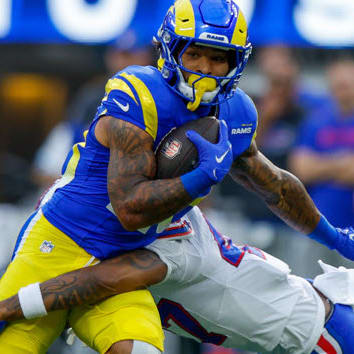This article series intends to cut through the noise of the broader prospect analysis that generally circulates through fantasy football internet media, specifically at the running back position.
More than any other, running back is one position where the evaluation is simple. Production and athletic testing win out, reliably. By focusing on production and standout athleticism you can quickly discern the general functions of a running back and the general effect they bring to the field.
This series will look only at the 2024 rookie running backs, highlighting the pertinent details in their prospect profiles and offering comparisons for how their NFL careers might unfold based on how things turned out for similar players in the past. This article will look at Isaac Guerendo and Braelon Allen.
You can view the first article (Jonathon Brooks and Trey Benson) here, the second article (Blake Corum and MarShawn Lloyd) here, and the third article (Jaylen Wright and Ray Davis) here.
Isaac Guerendo, SF (4th round, 129th overall)
Guerendo (6-foot, 221 pounds) was originally recruited to Wisconsin as a receiver prospect out of Indiana back in 2018, but even with rare track speed and a frame well-suited for further development no other big programs offered Guerendo a scholarship. Guerendo initially redshirted to move to running back and added 20 pounds of weight in that time.
Unfortunately for Guerendo, from 2019 to 2021 was all wiped out by injury – hamstring injuries in
This article series intends to cut through the noise of the broader prospect analysis that generally circulates through fantasy football internet media, specifically at the running back position.
More than any other, running back is one position where the evaluation is simple. Production and athletic testing win out, reliably. By focusing on production and standout athleticism you can quickly discern the general functions of a running back and the general effect they bring to the field.
This series will look only at the 2024 rookie running backs, highlighting the pertinent details in their prospect profiles and offering comparisons for how their NFL careers might unfold based on how things turned out for similar players in the past. This article will look at Isaac Guerendo and Braelon Allen.
You can view the first article (Jonathon Brooks and Trey Benson) here, the second article (Blake Corum and MarShawn Lloyd) here, and the third article (Jaylen Wright and Ray Davis) here.
Isaac Guerendo, SF (4th round, 129th overall)
Guerendo (6-foot, 221 pounds) was originally recruited to Wisconsin as a receiver prospect out of Indiana back in 2018, but even with rare track speed and a frame well-suited for further development no other big programs offered Guerendo a scholarship. Guerendo initially redshirted to move to running back and added 20 pounds of weight in that time.
Unfortunately for Guerendo, from 2019 to 2021 was all wiped out by injury – hamstring injuries in 2019 and 2020, then a Lisfranc injury in 2021. By the time Guerendo returned in 2022 Wisconsin already had Braelon Allen as an established starter, as well as Chez Mellusi who ran for nearly 100 yards per game even during Allen's highly-productive true freshman season. As a player returning from three consecutive serious injuries on a team with two running backs who combined for nearly 200 yards per game the prior year, Guerendo functioned as the RB3 on that 2022 Wisconsin team, running for 385 yards and five touchdowns on 64 carries (6.0 YPC).
It wasn't until Guerendo was able to transfer to Louisville that he was given a chance to play extensively. Guerendo was almost mostly inactive for four years for reasons entirely outside of his control. It's important to remember that.
When he finally got to Louisville, blessed with his second healthy season in a row, Guerendo unsurprisingly raked. The Cardinals already had a beloved four-year running back on the roster in Jawhar Jordan, so Guerendo wasn't given a true lead role in 2023, but that can be excused given Jordan's four-year head start with the program, not to mention the fact that Jordan would go on to be a sixth-round NFL pick himself.
[Skill set]
Guerendo was consistently effective when physically able to play at the collegiate level, both at Wisconsin and Louisville. The overall sample is small, especially for a five-year player, but as previously mentioned this was due to reasons fully out of Guerendo's control.
When on the field Guerendo ran with both safety-splitting speed and real power. Sometimes running backs with Guerendo's speed suffer the trade-off of worsened balance or compromised change of direction, but none of that appears to be the case with Guerendo. He's built for power and speed both and he utilizes both effectively.
Not only did Guerendo finish his collegiate career with 1,392 yards and 17 touchdowns on 231 carries (6.0 YPC), he was also a highly-effective receiver. Guerendo turned 52 career targets into 42 receptions for 358 yards and one touchdown (80.8 percent catch rate, 6.9 yards per target), likely making Guerendo one of the league's most capable pass catchers even right now. If Guerendo were to ever start a full season he would be a legitimate 60-plus reception threat.
[Tool set]
Guerendo's skill set is strong, but his tools grade is elite due to a 4.33-second 40, 41.5-inch vertical jump and 129-inch broad jump at 220 pounds. Guerendo's explosive and linear athleticism is close to unmatched, and he even did pretty well in the agility-oriented three-cone drill (6.94 seconds).
There are not three running backs more athletic than Guerendo in the NFL.
[Bottom line]
If Guerendo stays healthy, his sum of traits is too loud to stay on any given bench forever. Unfortunately, Guerendo's hamstring history already flared up in 49ers training camp, and Guerendo has been on the shelf since Wednesday.Christian McCaffrey is of course going nowhere in the meantime, though, so hopefully Guerendo can be recovered and stay healthy when there are actual reps up for grabs. If Guerendo can claim an eventual opportunity he will almost assuredly rake.
BEST-CASE COMPARISON: David Johnson. Guerendo is a lot faster than Johnson and a little bit lighter, but the theme of this comparison is the unique combination of high-upside running and receiving production Johnson offered, albeit in a brief run.
LIKELY COMPARISON: Raheem Mostert. If Guerendo can't stay healthy long enough to accumulate any David Johnson-like volume at any one point, then he should still be able to put together a career like Raheem Mostert – late-blooming if it must be, off-and-on every few years for a period – but this much speed, power and receiving ability can only be stopped by injury.
Braelon Allen, NYJ (4th round, 134th overall)
Allen (6-foot-1, 235 pounds) actually ran ahead of Guerendo when the two were at Wisconsin, but contrary to some narratives this isn't because Allen 'beat out' Guerendo for that role, As discussed in the Guerendo blurb, Allen and Chez Mellusi combined for nearly 200 rushing yards per game while Guerendo missed the 2021 season with a Lisfranc injury. If Guerendo had been healthy enough to compete in 2021 and if the Wisconsin coaches hadn't understandably been concerned about limiting Guerendo's workload in 2022 then things would have turned out much differently.
Of course, Allen was a dominant collegiate running back by any standard, and it's an impressive indication of his football character that Allen was able to start and dominate not just as a true freshman, but as a 17-year-old freshman who didn't turn 18 until Jan. 20 following the 2021 season. This reflects Allen's preparedness and work ethic, which was already at an NFL level out of high school.
[Skill set]
Allen is clearly both a natural and polished when it comes to the basics of running back play. His production says this – 3,494 yards and 35 touchdowns on 597 carries (5.9 YPC) – and it's also demonstrated by the fact that he was able to draw so much usage at such a young age.
Allen runs with all the power you would expect of a 235-pound back, yet Allen's bulkiness doesn't come at the expense of his flexibility or balance. Some running backs would become heavy-footed at Allen's build, but he remains nimble enough to keep his footing when stopping or changing direction.
In addition to his strong natural running abilities, Allen seems like a near-natural in pass protection, where his nimble feet again pay off and keep him balanced in the face of an engaging defender. Allen has made some notable plays as a receiver and seems to flash coordinated hands at the least, but it's not clear how well he can turn upfield given his returns meager returns as a receiver. Allen averaged more yards per carry than per target in college, catching 49 receptions for 274 yards and no touchdowns on 63 targets (77.8 percent catch rate, 4.3 YPT).
[Tool set]
This is where it goes wrong for Allen. Allen refused to run a 40-yard dash at the combine or the Wisconsin pro day, and the latter detail in particular is concerning because Wisconsin might have the fastest pro day track in the country. Everyone who runs on the Wisconsin track beats their combine 40 time by at least 0.1 seconds, and sometimes more. If Allen is unwilling to run on the Wisconsin track then it's probably because the time was still bad even on Wisconsin's generous track.
When you watch the game tape there are many plays that corroborate this speed concern. I'll name one in particular, which I've mentioned before: in Allen's freshman year against Purdue he ran for 140 yards and two touchdowns on just 12 carries. As it relates to the speed question, though, this game raised a serious concern for Allen's NFL projection on a play where Allen took a carry from the Wisconsin six-yard line. Allen breaks into the wide-open field and from about the 10-yard line transitions to a full sprint. It's about at that same time that Purdue safety Cam Allen (4.56-second pro day 40) can be spotted out of position to Cam's left, at which point Cam tries to stop his momentum to turn around and begin chasing Braelon, with Braelon about at the 11-yard line and Cam the 13. If Braelon ran so much as a 4.7-second 40 this play likely would have been a touchdown, but Cam and his 4.56 pro day 40 (likely a 4.65 at best at the combine) instead had the time to stop, turn around, and then sprint in the opposite direction to run down Braelon.
Not only did Cam Allen easily gain on Braelon on that run, but arguably even more concerning is how Purdue corner Dedrick Mackey was able to keep stride with Braelon while running over from the other side of the field. Mackey ran a 4.8-second pro day 40, which likely would have been a 4.85-second 40 at best on the combine track.
[Bottom line]
Allen's production in college was excellent and he has a handful of clearly standout traits – namely his power and blitz pickup potential – but his production in college was not truly remarkable by Wisconsin standards, and Allen's athletic testing might be prohibitively bad. If Allen runs a 4.8 40 like there is reason to suspect, then it basically makes him a non-consideration as an NFL starter.
Going back to 1999 the only player to log a 4.8 or worse and still produce to any notable extent as a runner is Le'Ron McClain (4.85-second 40), who was actually a fullback. McClain was also 256 pounds. Jason Snelling (4.79-second 40) is your other 'good-case' scenario here. Allen might be a fullback.
BEST-CASE COMPARISON: James Conner. At 6-foot-1, 235 pounds with a similar lean and similarly good passing-down abilities, Conner does look a lot like Allen in some ways. The reason I consider this outcome unlikely is that Conner ran a 4.65-second 40 at the combine, and I think Allen is more likely to run a 4.80 at best. To be fair, Allen (32-inch vertical, 117-inch broad) did log better jumps than Conner (29-inch vertical, 113-inch broad).
LIKELY COMPARISON: John Clay. I mentioned that Allen's otherwise great production was not actually that remarkable by Wisconsin standards. Clay is the exact player that Allen's biggest proponents don't want to hear about, because their similarities are almost identical right up until the point of their NFL careers. Allen ran for Allen finished his Wisconsin career averaging 5.9 yards per carry with a 5.86-percent touchdown rate over 597 carries, yet Clay averaged 5.4 yards per carry with a 6.52-percent touchdown rate over 629 carries. At 6-foot-1, 230 pounds Clay logged a 4.83-second combine 40.



































